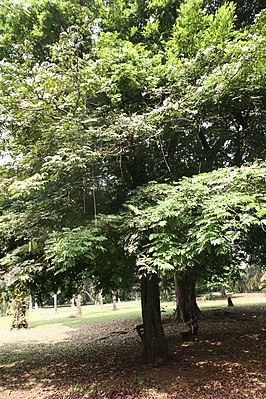Eperua falcata
| Eperua falcata | ||||||||||||
|---|---|---|---|---|---|---|---|---|---|---|---|---|

Eperua falcata |
||||||||||||
| Systematics | ||||||||||||
|
||||||||||||
| Scientific name | ||||||||||||
| Eperua falcata | ||||||||||||
| Aubl. |
Eperua falcata or Wallaba , wallaba tree , is a tree in the legume family in the carob subfamily. It occurs in northern Brazil , in the Guyanas and as far as Venezuela and Colombia as well as in Trinidad .
description
Eperua falcata grows as an evergreen tree, often with a spreading crown, up to 35–40 meters high. The trunk diameter reaches over 80 centimeters. There are buttresses or small buttress roots trained. The brownish to gray bark is slightly rough and slightly scaly. The tree has a reddish gum (wallaba gum).
The stalked, alternate and paired pinnate leaves have 4–6 leaflets . The slightly leathery, short-stalked and thin, bald leaflets are entire, ovate to elliptical or obovate and pointed or pointed to tail. The almost bald petiole is 2.5–4.5 centimeters long, the leaflets about 8-14 centimeters and the short, runny, almost bald petiole about 4-5 millimeters. The almost bald rachis is 4-8 centimeters long and the leaflets are somewhat covered with transparent glands. The small stipules are sloping. The young leaflets are reddish.
There are terminal, penduliflorous and clustered , almost bare inflorescences hanging on very long stems (0.5–2 meters) . The stalked flowers have a double flower envelope . There are sloping supporting leaves and two front leaves. The somewhat short-haired flower stalk is divided with a "joint". It is a short, cup-shaped, slightly brownish outside, short-haired and green flower cup , with a few nectar glands on the inside. The 4 unequal, thick, greenish sepals are boat-shaped, whitish to pink inside, reddish and bald and outside, more or less red-brownish, short-haired. There is a large, reddish, fan-shaped petal and 4 greatly reduced, small ones. The white-reddish, pink and long, 4–5 stamens and the 4–5, somewhat shorter staminodes, with small antherodes, are fused underneath in a short, hairy tube. The free stamens, above the tube, of the fertile, long stamens are bare, the shorter of the staminodes are partly hairy. A stamen next to it is free and hairy in the lower part. Approximately mid-sized, elongated and silky hairy ovary is stalked, gynophor , with a long, often curved, bare and reddish stylus with capitate scar .
The flowers are mostly pollinated by bats , but hummingbirds and woolly rats have also been seen.
The first pink, reddish, later brown, very flat and initially slightly, short, velvety hairy, later balding, slightly curved, sickle or machete to crook-shaped, woody and pointed legumes are formed on very long stems . They are 20–33 centimeters long, 6–9 centimeters wide and contain 2–5 flattened, up to 3.3–4 centimeters large, red-brown seeds with a thin, very finely textured seed coat and a thickened edge. The pods open explosively and throw the seeds ballochor many meters out.
use
The rather heavy, hard, well-resistant, difficult to treat wood is known as (Soft, White) Wallaba or Wopa , Wapa , and Palo machete .
The bark and gum are used medicinally.
literature
- J. Lanjouw, AL Stoffers: Flora of Suriname. Vol. II, Part II, Brill, 1976, ISBN 90-04-04581-3 , p. 28 ff.
- Franklin R. Longwood: Commercial Timbers of the Caribbean. Agriculture Handbook 207, USDA, 1962, p. 123 ff, limited preview in the Google book search.
- Ingrid Roth: Stratification of a tropical forest as seen in dispersal types. Junk Pub., 1987, ISBN 978-94-010-8639-4 , p. 94.
- RS Cowan: A Monograph of the Genus Eperua (Leguminosae: Caesalpinioideae). Smithsonian Contributions to Botany No. 28, 1975, online at biodiversitylibrary.org.
- M. Chudnoff: Tropical Timbers of the World. Agriculture Hanbook 607, USDA, 1984, p. 77.
- J. Gérard, D. Guibal, S. Paradis, J.-C. Cerre: Tropical Timber Atlas. Éditions Quæ, 2017, ISBN 978-2-7592-2798-3 , pp. 912 ff, limited preview in Google Book Search.
- AM Polak, HR Rypkema: Major Timer Trees of Guyana A Field Guide. Tropenbos, 1992, ISBN 90-5113-013-9 , online (PDF; 8.5 MB).
Web links
- Eperua falcata near Flore de Guyane (pictures).
- Eperua falcata at Useful Tropical Plants.
- Fabaceae, Eperua falcata, Bootlace tree on anthrome.wordpress.com, December 30, 2008.
- Eperua falcata (wapa) on lachaussetterouge.fr (pictures).
Individual evidence
- ^ IM Turner: The Ecology of Trees in the Tropical Rain Forest. Cambridge Univ. Press, 2001, ISBN 0-521-80183-4 , p. 148.
